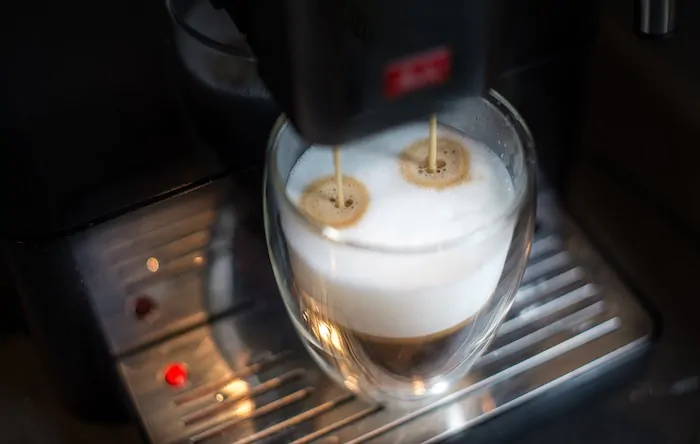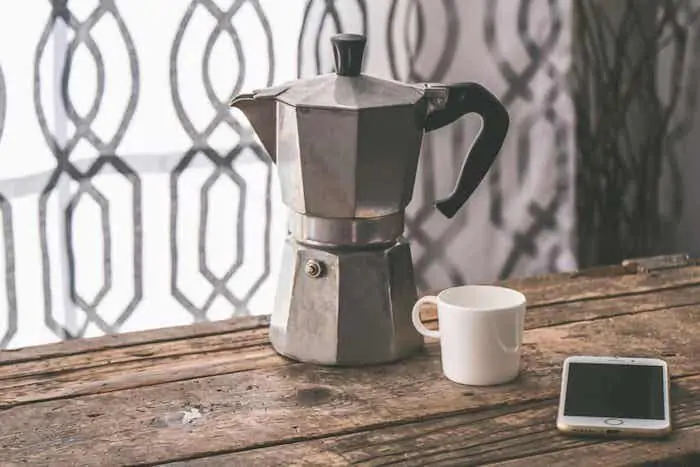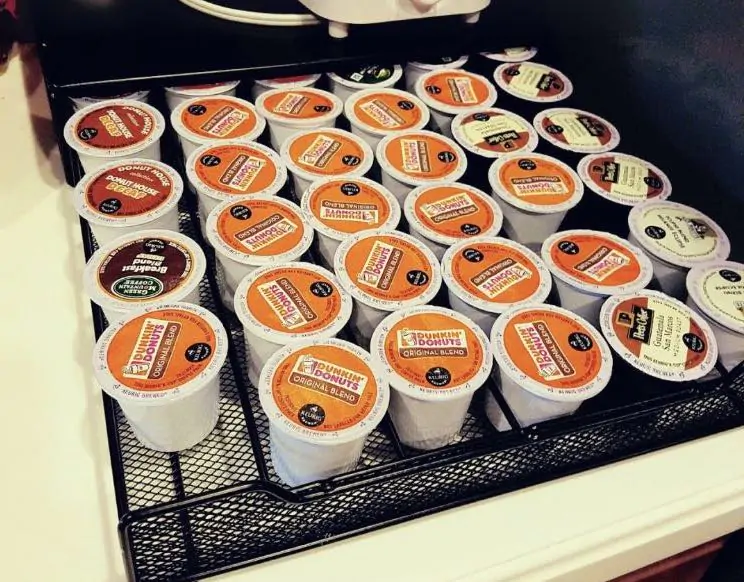If you’ve ever wondered are coffee machines worth it and if you should spend a little or a lot, we cover the pros and cons of buying one today.
Going out to get a big cup of coffee at a coffee shop is not only a hassle, but it usually costs a pretty penny. That can add up fast! This can make the idea of getting your own coffee machine for home use seem like a pretty promising investment. If you’ve ever wondered whether getting a coffee machine was worth it or not, then you’ve come to the right article!
Are coffee machines worth it? If you drink coffee every day or almost every day and you’re looking to make your own custom coffee for a lower cost and more convenience, then yes, buying a coffee machine is worth it.
Before you rush off to buy the nearest coffee machine you can find, there are some more important things to know. It’s not just about cost and convenience, so check out the information below before you make the decision to buy.
- Is getting a coffee machine worth the cost and maintenance?
- Why you should get your own coffee machine
- What kinds of coffee machines are there?
- What kind of coffee machine should you get?
- Buying your own coffee machine, pros and cons
- Is getting an expensive coffee machine worth it?
- Are Coffee Machines Worth It? The Final Word
- Related Questions
Is getting a coffee machine worth the cost and maintenance?

For some people, the concept of having coffee whenever they want is really appealing. But once they start looking into machines and specs and the maintenance involved, they get frustrated or overwhelmed. When it becomes too much, they end up buying the first coffee machine they see, not fully understanding how to take care of it.
So, of course, it gets broken, or nasty, or both and they don’t know why and how to fix it. I don’t know about you, but that doesn’t really strike me as a good time. It also sounds like a waste of money and my effort.
It’s true: coffee machines, no matter the kind, will always need some maintenance one way or another. Some even need more than others, enough that it might be considered a part-time job to maintain them. Taking proper care of it is the first, and probably most important, thing you need to know before getting your own coffee machine.
Now, you may be thinking something like “I have to not only buy this expensive machine but also clean it out as well?” but bear with me. Before you go and give up on coffee machines because it’s easier to buy a cup of Joe at your local bean distillery, I suggest that you should think about the cost and waste potential of living off of pre-made coffee.
While I can’t speak for everyone, I do believe that if you’re someone whole loves coffee and drink it fairly often, then buying a coffee machine would probably be quite beneficial to you, your budget, and the environment.
Besides, some coffee machines have such low maintenance requirements, it’s hardly more than changing a filter or rinsing the reservoir! I think most people have time for that.
You might be interested in our How To Clean Coffee Machines With A Coffee Brush guide.
Why you should get your own coffee machine
Even though I’m all for personal coffee machines, I have one of my own I use almost every day, I know that I can’t speak for everyone’s needs and capabilities. That said, I firmly believe that if you can afford to splurge on a coffee machine like this, then you should definitely give them a try. It’s also helpful to note that coffee machines aren’t always expensive. If you’ve got $10, you can likely find something that makes a decent, or at least passable, cup of coffee until you can upgrade.
The most useful part of purchasing your own coffee machine would be that you would save way more money per cup compared to buying from a coffee shop. That goes both in terms of cost and waste. But possibly the best reason to buy a coffee machine would be that you’re going to be getting your coffee much quicker if you have your own machine.
After all, you would just make your way to wherever you placed the machine in your home and brew a cup right then and there, as opposed to having to drive, walk, or cycle your way over to the nearest or best coffee shop.

Getting coffee at a coffee shop means that you have to buy the coffee per cup every time you want it. Worse yet, you have to make the trip over there and deal with the disposable cups and sometimes straws that they give you. Yuck! To make matters worse, you may also have to deal with them potentially messing up your order, or not even being able to serve you at all for some reason or another. That’s a wasted trip and a big cup of grumpy.
Compare that to if you were to make a one-time purchase of a coffee machine. You can then use your own cups, make the perfect amount of coffee you feel like making, and make coffee in the comfort of your pajamas. Plus, you can make your coffee any darn way you want, experiment with flavors and ratios, and have some fun, too. Besides, unless you’re buying super expensive beans, the price of a homemade cup is usually lower than that of a coffee shop cup of the same size.
What kinds of coffee machines are there?
In case you were afraid that there weren’t enough coffee machines out there to choose from, rest assured, there are actually quite a few! That makes your chances of finding the perfect one for you all the higher. Granted, too many choices can be just as bad as not having enough choices, but that’s why I’m here to help.
While I can’t list every single type of coffee machine out there, because there’s a lot, what I can do is give general information about the type of coffee machines that there are. From there, you can decide which types are more your style and fit within your budget. That takes the guesswork out and cuts your research time considerably. And, of course, that gets you drinking your delicious coffee a lot faster, which is the most important part.
Single Serve Coffee Machines
First up is single serve coffee machines like this. As their name suggests, these are machines that make one serving of coffee at a time, rather than making huge pots only. All you have to do is pop one of their little coffee pods into the machine, press a button, and bam, you have coffee. The downside is that the pods can get expensive and not all are biodegradable. The upside is that many of these machines can take reusable coffee pods that you simply fill with your beans of choice.
Drip Coffee Machines
Next up are drip coffee machines, which are pretty widely available. They are also usually the cheapest. Unfortunately, they often have a heating pad under the pot to keep the coffee warm, and if left on too long, it can cook or even burn the coffee. That results in a bitter brew that I wouldn’t even serve to my worst enemy. To get around this drawback, transfer your coffee into a heat-retaining container instead of leaving it on the warming pad.
If you like the idea of a drip coffee machine but don’t want to cook your coffee (who does?), then may I introduce the thermal coffee machine.
Espresso Machines
Espresso machines like this are a specialty machine, and as such are usually very expensive. There are smaller home models and huge professional models, so there is some variety there.
Percolators
If you want a stronger coffee but don’t really want to spend the big bucks on an espresso machine, then perhaps a percolator is what you crave.
Siphon Coffee Makers
If you want an uncommon coffee machine, then there are ones knows as siphon coffee makers, or vacuum pot coffee makers. They are unique and different, but make a pretty stellar cup of Joe.
Moka Pot

And lastly is the Moka Pot. It’s an Italian stove-top coffee maker that makes a nice and strong cup of coffee. There are electric ones, but they can get kind of pricey.
So, with all these different types of coffee machines, this really begs the question…
What kind of coffee machine should you get?

It can be a little hard to pick out your perfect counter companion with so many to choose from. While I can’t tell you what the best coffee machine for you specifically is, as I am not magical, I can hopefully at least give you the information needed to pick out the best machine.
For ease of use, I’d recommend looking into the single-serve coffee machines. They’re easy to use, usually pretty small, and quick to get your fix in minutes. The bad news is that their little coffee pods not only get expensive after a while, but they also leave a lot of plastic waste, as mentioned above. On the plus side, some of these single-serve coffee machines also have reusable coffee pods or can take off-brand reusable coffee pods.
One of the popular choices of these would be the Keurig reusable K-Cup, which is actually what I have in my kitchen right now. The upside to the reusable pods, other than loving Mother Nature, is that I can use whatever beans I want.
If you want something cheaper, drip coffee machines might be what you need. If you don’t mind spending a little more to avoid potentially burning your coffee, then a thermal drip coffee machine might be worth it instead. These coffee machines usually only make large pots of coffee, however.
While I’m personally most likely not going to, it’s entirely up to you if you’re willing and able to get a fancy espresso machine. If you can look past their awful prices and high maintenance, then they can make some really great espresso. The maintenance is what scares most people away. They are labor intensive machines.
While they can’t make actual espresso, a percolator or Moka Pot can get pretty close, and for a fraction of the cost and effort.
Vacuum pot coffee makers are uncommon and pretty fun to watch, but their fragility and high maintenance make them less of a daily coffee maker, and more of a fun little thing to bust out to impress guests.
Buying your own coffee machine, pros and cons
Here I have compiled a nice short-and-sweet pros and cons list for your reading pleasure!
Pros
- You can have coffee whenever you want
- It’s more convenient than going on a coffee run
- You have many different options of machines and brands to pick from
- Depending on the machine you get, you can use almost any flavor or type of coffee of your choosing
Cons
- You don’t really want to risk getting a low-cost machine as the taste might degrade the lower you go. The good machines are quite costly
- Depending on the type and model that you want, they can sometimes take up a decent amount of space, which may be bad for places like studio apartments
- The maintenance on some machines can sometimes be messy and make you wonder why you bought the thing in the first place
- Some machines have a larger learning curve that can take a lot of time to learn completely
Is getting an expensive coffee machine worth it?
One more thing before I finish this article. For most things, the more expensive something is, the more professional or superior it is. But can the same thing be said about coffee machines? And would it really be worth all the hassle and cost that these beefy machines come with?
If you were to dive into personal espresso machines, you would probably be taken aback by their hefty prices and incredible sizes, and I don’t blame you. Each fancy and high-end machine, espresso or otherwise, claims to make the best coffee ever and be well worth the price. While these kinds of machines would fit in a coffee shop, they probably wouldn’t really play nicely in the average home.
If you want my personal opinion: no, getting a super coffee machine for everyday household use wouldn’t really be worth it. Unless you’re super picky about your coffee and are willing to learn to use a professional machine, the cost and maintenance of one of these big boys would probably be too much to deal with.
Are Coffee Machines Worth It? The Final Word
More often than not, a good personal coffee machine is well worth the cost. You’ll not only be saving more money per cup as opposed to buying at a coffee shop, but it’s also faster and more convenient than going out to your local coffee place. I’m not saying to ditch your local coffee joint all together.
You can very well still go as a treat every now and then. It’s just that buying a personal coffee machine can really save you all that trouble and money. And not to mention it can be fun to experiment with different types of coffee brewing methods and flavors all on your own, almost like a coffee scientist.
Further Reading
The Best Coffee Maker With Grinder For Your Dream Coffee
The Best Home Coffee Roaster Machines
Related Questions
Can you use any type of ground coffee in a coffee machine?
This mostly depends on the type of coffee machine you decide to go with, but you can usually use any kind of beans you want, granted you follow your coffee machine’s instructions and suggested grind size. That said, some coffee machines require speciality cups, like Keurig and Nespresso, but also have options like reusable K-cups. Always research your chosen coffee machine before buying. If a machine says to only use their special cups, then you should adhere to that.
Do single cup coffee makers make instant coffee?
While a single cup coffee machine does use little pods to make your coffee, and pretty fast, it does not actually qualify as instant coffee. Instant coffee is a powder that you mix into hot or cold water to create coffee. If you were to open one of these single serve pods, you would most likely find plain old coffee grounds inside instead of instant coffee powder.
Source:
https://www.smartfamilymoney.com/cost-of-k-cup-vs-drip-coffee/ https://www.thekitchn.com/7-things-to-do-before-buying-a-coffee-maker-242296
https://coffee-channel.com/different-types-of-coffee-makers/
https://coffeegearathome.com/is-a-single-serve-coffee-maker-worth-it-heres-what-we-think/

very informative posts